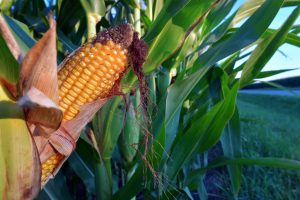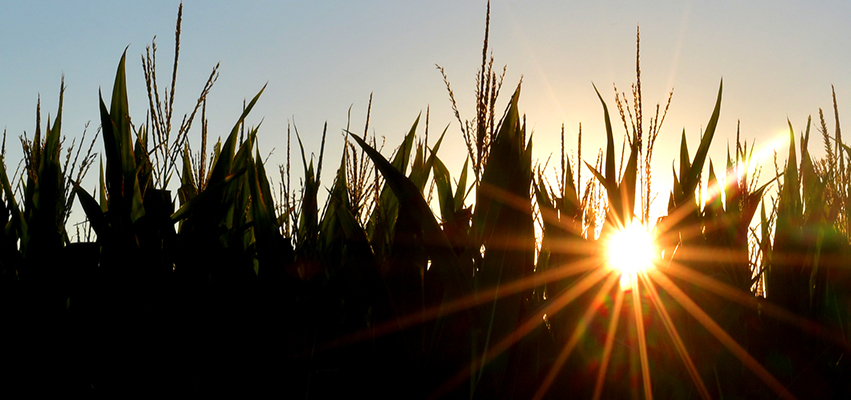In Illinois, corn historically has been king, flanking one’s every move if you drive about the state in summer or fall.
But this year, for the first time in almost 40 years, soybean acreage exceeded corn in the state. There was still a lot of corn planted: 10.7 million acres, according to the U.S. Department of Agriculture, but soybean acreage totaled 11.2 million acres.
FOR THE FIRST TIME IN ALMOST 40 YEARS, SOYBEAN ACREAGE
EXCEEDED CORN: 10.7 MILLION ACRES OF CORN,
11.2 MILLION ACRES OF SOYBEANS
“Many (farmers) decided to not plant corn on corn again but to rotate with soybeans to go for even higher yields that could rival corn profit potential,” said Stephanie Porter, outreach agronomist for the Bloomington-based Illinois Soybean Association.
Other factors include the growing demand for biodiesel, the blend of soybean oil with diesel fuel, and the dramatic rise in the cost of nitrogen fertilizer, an input considered necessary for corn production, she said.
Patrick Kirchhofer, manager of the Peoria County Farm Bureau, noted that farmers looked at corn input costs that effectively doubled in a year.
“Russia’s invasion of Ukraine spiked nitrogen prices further,” he said. Russia and Ukraine together export about one-third of the fertilizer containing nitrogen and phosphorus that farmers use.
 But central Illinois farmers such as Rob Asbell in Brimfield aren’t complaining about this year’s harvest. “I’d rate this year good to excellent with beans ‘very good’ and the corn ‘pretty good,’” he said.
But central Illinois farmers such as Rob Asbell in Brimfield aren’t complaining about this year’s harvest. “I’d rate this year good to excellent with beans ‘very good’ and the corn ‘pretty good,’” he said.
Asbell, who’s farmed for more than 20 years, knows that others in the state haven’t been so lucky. “Logan County, which had no rain this year, was underwater last year,” he said.
Mark Read, who farms 2,200 acres with his brother Chuck in Putnam and Bureau counties, said last season’s results were good but he expects even better this year, speculating on yields of 250 bushels of corn and 75 bushels of soybeans per acre.
Read echoed Asbell in recognizing that farmers in this part of the state were fortunate. “We didn’t get the storms like southern Illinois did where they had 11-inch rains,” he said.
A district director for the state’s soybean association, Read has traveled widely as a soybean ambassador. “We were just over in Nigeria, the most populous country in Africa, to show why U.S. soybeans are better,” he said. American beans compete globally against those grown in Brazil, Argentina and Paraguay, said Read.
On a previous trip to Honduras in Central America, Read inspected a system for raising tilapia that were being fed meal from U.S. soybeans exclusively. “Then they ship those fish back to the U.S. for sale,” he said.
The success of soybeans isn’t the only issue on the horizon for corn growers, however. With 40 percent of U.S. corn currently used for ethanol as an additive in gasoline, observers have raised the question: What happens when American motorists adopt electric vehicles?
Earlier this year, the Des Moines Register, a newspaper in the heart of Iowa, the other major corn-producing state along with Illinois, ran an op-ed that suggested “it’s time to pivot and figure what’s next … after ethanol.”
“Think about it,” said independent ag columnist Alan Guebert. “By 2035, there won’t be a single auto manufacturer building an internal combustion engine. Ethanol is a doomed product,” he said.
“Americans didn’t have a choice when the Clean Air Act was passed in 2007,” said Guebert, referring to federal mandates that required ethanol to be blended into motor fuel. “They have a choice now,” he said, referring to the rising number of electric vehicles on the market.
‘BY 2035 THERE WON’T BE A SINGLE AUTO MANUFACTURER
BUILDING AN INTERNAL COMBUSTION ENGINE’
— Alan Guebert
But Guebert, whose brother Richard heads the Illinois Farm Bureau, knows ethanol won’t go down without a fight. “Farmers have a strong lobby that will keep the ethanol balloon up,” he said.
Bill Leigh, a farmer in Marshall County and past president of the Illinois Corn Bureau, isn’t pressing the panic button regarding the future of ethanol. “We’re not ready to give up on the alternative fuel side. Higher octane fuels — with ethanol — will be good for the consumer as we move to electric,” he said.
Leigh ticked off other reasons for optimism: a big uptick in exports of ethanol blends, using ethanol in aviation fuel, and the prospect of new products to come, he said.
While visiting a farm in Leroy, Illinois in August, U.S. Agriculture Secretary Tom Vilsack addressed the ethanol question.
“Detroit is going to continue to make combustion engines. From now until 2035, people are going to keep their trucks and their cars for an extended period of time,” he said. “The future of the (ethanol) industry in terms of transportation, in terms of cars and trucks, is still very valid,” he said.





